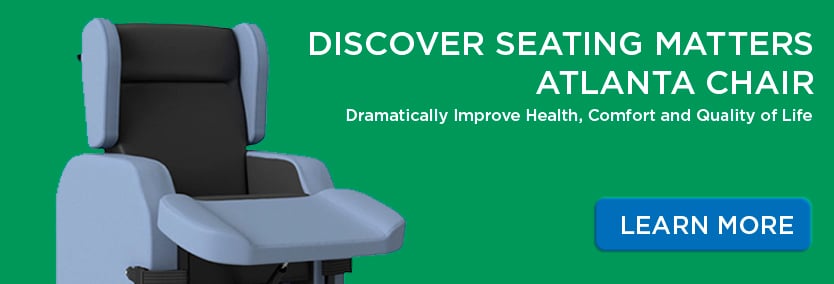Margaret, an 81 year old female with a history of pneumonia, had recently suffered a stroke (CVA). She had a high risk of pressure injuries and had developed a red area on her left heel*.
As a result of her stroke, Margaret had left sided weakness, creating an imbalance in weight distribution and a high risk of pressure injuries. She also wore a pressure management boot to protect the red area which had developed on her heel. Margaret had previously sat in her old chair for up to 6 hours each day and preferred to stay in bed as she was so uncomfortable in her chair, regularly taking paracetamol due to her pain and discomfort. Because of her unwillingness to sit up for long periods of time, Margaret, a sociable person, often missed out on various activities which she enjoyed within the home.
CLICK HERE TO VIEW THE ATLANTA CHAIR
Caregivers struggled to position Margaret comfortably within her chair and were aware of the frequent pain that she was in, resulting in great frustration for them. Caregivers attempted to use pillows for comfort and support, correcting her posture regularly throughout the day. As well as the pain that Margaret was in, she also had postural issues such as a right sided pelvic obliquity and a pelvic rotation. Her feet were not loaded, nor were her legs elevated, encouraging oedema, or swelling in her lower limbs. Margaret had limited hip flexion on her affected left side, which made her assume a near lying position in the chair, contributing to the deviations in her pelvis.
Because Margaret’s body, including her feet, was fully loaded within the chair, her weight was distributed over a larger surface area, which significantly reduced her pressure injury risk. The level of pressure management included in the leg rest, combined with an elevated position, ensured that the risk of breakdown on her heels was minimized.
One of the most pivotal advantages of Margaret’s new chair, was the impact on her ability to socialize within the home. The new chair also enabled Margaret to attended a religious service that was of great importance to her, where previously she would not have been able to tolerate it, due to the extended period where she would have had to sit out.
CLICK HERE TO VIEW THE ATLANTA CHAIR
*This case study should not be interpreted as a predictor or guarantee of future financial or clinical outcomes with different patients. Clinicians and users must employ correct decision making, undertake proper assessments, education, comply with local regulations and ensure correct use of equipment.





